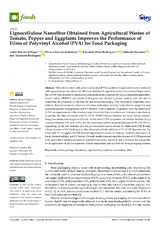Mostrar el registro sencillo del ítem
Lignocellulose Nanofibre Obtained from Agricultural Wastes of Tomato, Pepper and Eggplants Improves the Performance of Films of Polyvinyl Alcohol (PVA) for Food Packaging
| dc.contributor.author | Bascón-Villegas, Isabel | |
| dc.contributor.author | Sánchez-Gutiérrez, Mónica | |
| dc.contributor.author | Pérez-Rodríguez, Fernando | |
| dc.contributor.author | Espinosa, E. | |
| dc.contributor.author | Rodríguez, Alejandro | |
| dc.date.accessioned | 2021-12-13T10:57:25Z | |
| dc.date.available | 2021-12-13T10:57:25Z | |
| dc.date.issued | 2021 | |
| dc.identifier.uri | http://hdl.handle.net/10396/22205 | |
| dc.description.abstract | Films formulated with polyvinyl alcohol (PVA) (synthetic biopolymer) were reinforced with lignocellulose nanofibres (LCNF) from residues of vegetable production (natural biopolymer). The LCNF were obtained by mechanical and chemical pre-treatment by 2,2,6,6-tetramethylpiperidine-1-oxyl radical (TEMPO) and added to the polyvinyl alcohol (polymer matrix) with the aim of improving the properties of the film for use in food packaging. The mechanical properties, crystallinity, thermal resistance, chemical structure, antioxidant activity, water barrier properties and optical properties (transparency and UV barrier), were evaluated. In general, with the addition of LCNF, an improvement in the studied properties of the films was observed. In terms of mechanical properties, the films reinforced with 7% LCNF TEMPO showed the best results for tensile strength, Young’s modulus and elongation at break. At the same LCNF proportion, the thermal stability (Tmax) increased between 5.5% and 10.8%, and the antioxidant activity increased between 90.9% and 191.8%, depending on the raw material and the pre-treatment used to obtain the different LCNF. Finally, a large increase in UV blocking was also observed with the addition of 7% LCNF. In particular, the films with 7% of eggplant LCNF showed higher performance for Young’s modulus, elongation at break, thermal stability and UV barrier. Overall, results demonstrated that the use of LCNF generated from agricultural residues represents a suitable bioeconomy approach able to enhance film properties for its application in the development of more sustainable and eco-friendly food packaging systems. | es_ES |
| dc.format.mimetype | application/pdf | es_ES |
| dc.language.iso | eng | es_ES |
| dc.publisher | MDPI | es_ES |
| dc.rights | https://creativecommons.org/licenses/by/4.0/ | es_ES |
| dc.source | Foods 10(12), 3043 (2021) | es_ES |
| dc.subject | Plastic package | es_ES |
| dc.subject | Biorefinery | es_ES |
| dc.subject | Agri-food by-products | es_ES |
| dc.subject | Valorisation | es_ES |
| dc.subject | Films | es_ES |
| dc.title | Lignocellulose Nanofibre Obtained from Agricultural Wastes of Tomato, Pepper and Eggplants Improves the Performance of Films of Polyvinyl Alcohol (PVA) for Food Packaging | es_ES |
| dc.type | info:eu-repo/semantics/article | es_ES |
| dc.relation.publisherversion | https://doi.org/10.3390/foods10123043 | es_ES |
| dc.relation.projectID | Gobierno de España. PCI2020-112015 | es_ES |
| dc.relation.projectID | Gobierno de España. FPU17/05512 | es_ES |
| dc.rights.accessRights | info:eu-repo/semantics/openAccess | es_ES |

